Building Speed and Accuracy on Guitar
Improving speed and accuracy on the guitar is a goal for many players, whether you’re a beginner looking to improve your basic techniques or an advanced player seeking to refine your skills. This guide will walk you through some strategies and exercises that can help you play faster and more precisely, without sacrificing the quality of your sound.
Understanding the Importance of Speed and Accuracy
Speed and accuracy on the guitar are more than just flashy skills—they’re vital for expressing musical ideas clearly and effectively. Speed allows you to execute complex passages with ease, while accuracy ensures that every note is clear and intentional. Balancing both is key to becoming a versatile and confident guitarist.
Before diving into specific exercises, it’s important to remember that building speed and accuracy takes time and patience. It’s better to play slowly and correctly than quickly and sloppily. Consistent practice is essential, so make these exercises part of your regular routine.
1. Warm-Up Exercises
Before you start working on speed, it’s crucial to warm up your hands and fingers. Warming up helps prevent injury and prepares your muscles for more intense practice. Here are a few effective warm-up exercises:
2. Chromatic Scales
Play a chromatic scale, starting on the low E string, and work your way up the fretboard. Use all four fingers, one per fret, and alternate your picking between downstrokes and upstrokes. Start slow, focusing on clean transitions between notes.
3. Spider Exercise
Place your fingers on the first four frets of the low E string, starting with your index finger. Play each note sequentially, moving one finger at a time. Continue this pattern across all six strings. This exercise helps with finger independence and coordination.
4. String Skipping
Choose any scale or pattern and play it across non-adjacent strings. For example, play a note on the low E string, then skip to the D string, and so on. This challenges your picking hand and helps with accuracy when changing strings.
Building Speed Gradually
One of the biggest mistakes guitarists make when trying to build speed is rushing through exercises. It’s important to start slow and gradually increase your speed over time. Here’s how you can do it:
1. Use a Metronome
Start by playing a simple scale or riff at a slow tempo, using a metronome to keep time. Once you’re comfortable and can play the passage cleanly, increase the tempo by a few beats per minute (BPM). Repeat this process, only speeding up when you can play the passage perfectly.
2. Focus on Small Sections
Instead of trying to play an entire song or solo at high speed, focus on small sections—just a few notes or a single lick. Work on these sections until you can play them quickly and accurately before moving on to the next part.
3. Alternate Picking
Alternate picking is essential for fast playing. Practice alternate picking on scales and simple melodies. Start with down-up strokes at a slow tempo, then gradually increase your speed. Pay attention to your pick angle and grip—these can greatly affect your speed and accuracy.
Check out this YouTube playlist of videos designed to make your fingers stronger and more dexterous. The videos focus on alternate picking, hammer-ons, pull-offs, and working on different finger patterns.
Accuracy is Key
While speed is important, accuracy should never be sacrificed. Here’s how to maintain precision as you increase your speed:
1. Economy of Motion
Minimize the movement of your fingers and pick. Keep your movements small and efficient. The less your fingers have to move, the faster you’ll be able to play. This is particularly important for both your fretting and picking hands.
2. Clean Fretting
Make sure every note you play rings out clearly. This means pressing down just enough to get a clean sound, without pressing so hard that you tire out your fingers or cause unnecessary strain. Practicing legato techniques (hammer-ons and pull-offs) can also help improve accuracy.
3. Practice with Dynamics
Practice playing the same passage at different volumes and with varying intensity. Playing with dynamics not only helps with control but also improves your ability to play accurately under different conditions.
Common Mistakes to Avoid
As you work on building speed and accuracy, be mindful of these common pitfalls:
1. Rushing the Process
It’s tempting to try to play fast right away, but this often leads to sloppy playing. Take your time and build speed gradually.
2. Ignoring Technique
Speed comes from proper technique. If you’re not playing with good posture, proper hand positioning, or correct picking technique, you’ll hit a speed ceiling.
3. Skipping Warm-Ups
Never skip your warm-up routine. It’s essential for preventing injury and ensuring that your hands are ready for more intense practice.
4. Playing Too Loudly
Playing too loudly can lead to tension in your hands and arms, which can impede your speed. Focus on playing with control rather than brute force.
The Importance of Consistency in Developing Speed and Accuracy
Consistency is key when it comes to improving speed and accuracy. Set aside regular practice time each day, even if it’s just 15-30 minutes. Over time, you’ll notice significant improvements in both your speed and your ability to play accurately.
Track Your Progress
One effective way to stay motivated and measure your improvement is to track your progress. Record yourself playing scales, exercises, or songs at different tempos and compare these recordings over time. You’ll be able to see (and hear) how much you’ve improved, which can be incredibly encouraging.
The Coda
Building speed and accuracy on the guitar is a challenging but rewarding process. By focusing on proper technique, practicing regularly, and gradually increasing your speed, you’ll become a more confident and versatile guitarist. Remember, the goal is not just to play fast but to play fast and accurately.
If you’re serious about improving your guitar skills, consider taking lessons with Green Hills Guitar Studio. Whether you’re in Nashville or prefer remote lessons online, our experienced instructors can help you achieve your goals. Contact us today at Green Hills Guitar Studio to start taking guitar lessons!






